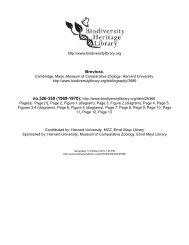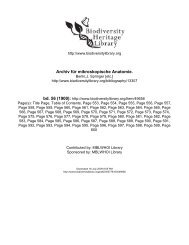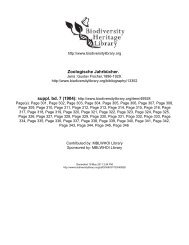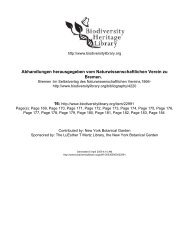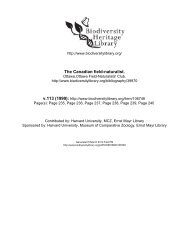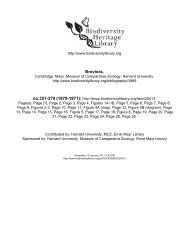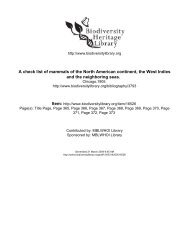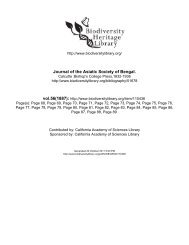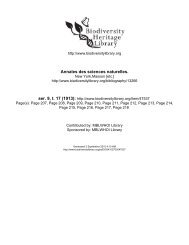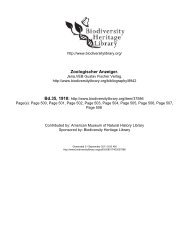An account of the geographical distribution of the marsupials and ...
An account of the geographical distribution of the marsupials and ...
An account of the geographical distribution of the marsupials and ...
Create successful ePaper yourself
Turn your PDF publications into a flip-book with our unique Google optimized e-Paper software.
http://www.biodiversitylibrary.org<br />
Proceedings <strong>of</strong> <strong>the</strong> Zoological Society <strong>of</strong> London.<br />
London :Academic Press, [etc.],1833-1965.<br />
http://www.biodiversitylibrary.org/bibliography/44963<br />
1909, pp. 545-952 (May-Dec.): http://www.biodiversitylibrary.org/item/97672<br />
Page(s): Page 803, Page 804, Page 805, Page 806, Page 807, Page 808, Page 809, Page 810,<br />
Page 811, Page 812, Page 813, Page 814, Page 815, Page 816, Page 817, Page 818, Page<br />
819, Page 820, Page 821, Page 822, Page 823, Page 824, Page 825, Page 826, Page 827,<br />
Page 828, Page 829, Page 830, Page 831, Page 832, Page 833, Page 834, Page 835, Page<br />
836, Page 837, Page 838, Page 839, Page 840, Page 841, Page 842, Page 843, Page 844,<br />
Page 845, Page 846, Page 847, Page 848<br />
Contributed by: Smithsonian Institution Libraries<br />
Sponsored by: Biodiversity Heritage Library<br />
Generated 15 July 2011 1:00 AM<br />
http://www.biodiversitylibrary.org/pdf3/007396400097672
This page intentionally left blank.
The following text is generated from uncorrected OCR.<br />
[Begin Page: Page 803]<br />
1909.] GEOGRAPHICAL DISTRIBUTION OP MARSUPIALS ETC. 803<br />
The following papers were lead : —<br />
1. <strong>An</strong> Account <strong>of</strong> <strong>the</strong> Geographical Distribution <strong>of</strong> <strong>the</strong><br />
Marsupials <strong>and</strong> Monotremes <strong>of</strong> South-West Australia,<br />
having special reference to <strong>the</strong> specimens collected<br />
during <strong>the</strong> Balston Expedition <strong>of</strong> 1904-1907. By<br />
G. C. Shortridge *.<br />
[Received May 7, 1909.]<br />
(Text-figures 244-277.)<br />
List <strong>of</strong> Western Australian Marsupials <strong>and</strong> Monotremes<br />
South <strong>of</strong> <strong>the</strong> Trojncs.<br />
Maceopus gi&axtel's Zimm. S.W.<br />
„ EOBUSTUS CEKYIXT7S TllOS. N.W. C.<br />
[ „ robxistus eruhescens'f isc\a.t. S.E.]<br />
„ KUFUS Desm. N.W. C. S.E.
„ lEMA Jom-d. S.W.<br />
„ EUGENii Desm. S.W.<br />
„ BEACHTUEUS Quoy & Gaim. S.W.<br />
Peteogale lateealis Gld. S.W. (N.W.?)<br />
„ LATEEALIS HACKETTI TllOS. S.W. (ilisular).<br />
Ontchogale lunata Gld. S.W.<br />
Lagosteophus fasciatus Per & Les. N.W. (insular).<br />
„ PASCIATUS ALBIPILIS Gld. S.W.<br />
Lagoechestes niESUTUS Gld. S.W.<br />
„ HiEsuTUS BEEXiEEi TllOS. N.W. (iusular).<br />
„ HIESUTUS DOEKE^ TllOS. N.W. (iiisular).<br />
BETi02fGiA PENiciLLATA Gray. S.W.<br />
„ LESUEUEi Quoy & Gaim. N.W. (insular).<br />
„ LESUEUEI GEAYI Gld. S.W.
POTOEOUS GILBEETI Gld. S.W.<br />
„ PLATTOPS Gld. S.W.<br />
Taesipes sPENSEEJi Gray. S.W.<br />
Deomicia concinn a Gld. S.W. C.<br />
PSEUDOCHIEUS OCCIDEXTALIS TllOS. S.W.<br />
Teichosueus tulpecula Kerr. S.W. (C, a rare straggler.)<br />
[Fhascolomys sp.\ 'f] S.E.?<br />
Thalacomxs lagotis Reid. S.W. N.W. C.<br />
ISOODO>' OBESULUS Sliaw. S.W.<br />
Peeameles bougainvillei Quoy & Gaim. N.W. (insular).<br />
„ BOUGAIXVILLEI MT0SUE03 Wagn. S.W.<br />
' [C/icej-opits msteMo^is t Gray.] (S.W.?) (N.W.?)<br />
Dastueus GEOFFEOxi eoetis Thos. S.W.<br />
Phascogale flavipes leucogastee Gray. S.W.<br />
,, CALUEA Gld. S.W.<br />
'"- Communicated by Mr. Oldfield Thomas, F.R.S., F.Z.S.<br />
t Occurrence in Son tli- Western Australia not yet confirmed.<br />
PBGC. ZooL. Soc— 1 909, No. LY. 55
[Begin Page: Page 804]<br />
^04 MR. G. C. SHORTRIDC4E ON GEOGRAPHICAL DISTRIBLTIOX [NoV. 23,<br />
Phascogale penicillata Shaw. S.W. (C.r)<br />
„ APicALis Gray.<br />
[ „ SZJ^ff* Woodward?]? N.W.? C?<br />
SmijVthopsis muhina Waterh. S.W.<br />
„ chassicaudata Gld. S.W. N.W. C.<br />
l^Autechinoiiit/s spencevl Tlios.] ? C?<br />
Mtrmecobius FASciAxrs Waterh. S.W.<br />
\_Notoryctes ti/pJdops* Stirling.] ? C ? S.E.?<br />
Tachyglossus aculeatus iseptus Thos. S.W. C. N.W.<br />
* Occurrence in Sonth-Western Australia not yet confii'med.<br />
[Begin Page: Page 805]<br />
1909.] OF MARSUPIALS AND MONOTREMES IX S.W. AUSTRALIA. 805<br />
Text-fi2-. 245.
Map showing Mammalian Famnstic regions <strong>of</strong> Western Australia.<br />
Macropus giganteus Zimm. (Text-fig. 246, p. 806.)<br />
Confined to <strong>the</strong> South- Western districts : plentiful except in<br />
<strong>the</strong> neighbourhood <strong>of</strong> towns — being replaced in <strong>the</strong> North-West,<br />
Central, <strong>and</strong> South-East by Macropus rufus — extending along <strong>the</strong><br />
coast as far north as Geraldton, inl<strong>and</strong> from which town, how-<br />
ever, <strong>the</strong> Red Kangaroo is said to be <strong>the</strong> more plentiful species,<br />
55*<br />
[Begin Page: Page 806]<br />
806 MR. G. C. SHORTllIDGE ON GEOGRAPHICAL DISTRIBUTION [Xov. 23,<br />
Not occurring beyond, if as far, as Esperance in <strong>the</strong> Soutli-East,<br />
where it is agnin replaced by <strong>the</strong> Red.<br />
Text-fig. 246 *.<br />
WESTERN<br />
AUSTRALIA<br />
•eorgeS'^<br />
Map showing <strong>distribution</strong> <strong>of</strong> 3Iacropus giganteus.
As with most <strong>of</strong> <strong>the</strong> species common to both States, <strong>the</strong> area in<br />
which it occurs in <strong>the</strong> West is sepai-ated from that in South<br />
* On this <strong>and</strong> following maps <strong>the</strong> dotted area indicates ascertained present range,<br />
horizontal lines — probable range, vertical lines — extinct, <strong>and</strong> crossed lines — dying<br />
out.<br />
[Begin Page: Page 807]<br />
1909.] OF MARSUPIALS AND MOXOTREMES IX S.W. AUSTRALIA. 807<br />
Australia by a wide tract <strong>of</strong> dry desert country fi'om six to eight<br />
liundred miles in width.<br />
lu <strong>the</strong> extreme South- Western coastal districts <strong>the</strong>re appears<br />
to be a somewhat dai-ker race, which is particularly noticeable in<br />
immature individuals, — <strong>the</strong> head, limbs <strong>and</strong> tail being frequently<br />
almost entirely black, possibly corresponding with Macrcqms<br />
giganteus melanops <strong>of</strong> Eastern Australia.<br />
19 specimens collected. Albany (King River) ; Bevei4ey (Stock<br />
Pool) ; Brookton (Dwaladine) ; Pinjelly (Woyaline Wells) ;<br />
Margaret River (Burnside) (caves).<br />
Grey Kangaroo ( S ' Boomer') <strong>of</strong> Colonists.
'Eonga' c?,'Woyre' $ (S.W.) ; ' Eowit ' (Moore River), <strong>of</strong><br />
natives.<br />
Macropus robustus cervinus Thos. (Text -fig. 247, p. 808.)<br />
Frequenting rocky hills <strong>and</strong> mountain lunges in North- Western<br />
<strong>and</strong> parts <strong>of</strong> Central West Australia:, extending south to Sou<strong>the</strong>i-n<br />
Cross <strong>and</strong> inl<strong>and</strong> as far as Laverton, in which places, however, it<br />
seems to be less abundant.<br />
Most plentiful towards <strong>the</strong> Noi'th-West, where in favouiuble<br />
situations it extends to <strong>the</strong> coast. Said to occur as far north as<br />
Port Hedl<strong>and</strong>.<br />
Known to colonists as <strong>the</strong> ' Hill Kangaroo,' to distinguish it<br />
from <strong>the</strong> ' Red ' or ' Plain Kangaroo.'<br />
3 specimens collected. Gascoyne River (Wyndham Range)<br />
(Clifton Downs station).<br />
' Bigodar ' (N.W.), ' Euro ' (C), <strong>of</strong> natives.<br />
Macropus robustus erubescens Sclat. (Text-fig. 248, p. 809.)<br />
Of South Australia, is said to occur in <strong>the</strong> extreme South-East<br />
<strong>of</strong> Western Australia to <strong>the</strong> east <strong>of</strong> <strong>the</strong> Eraser Range.<br />
Macropus rufus Desm. (Text-fig. 249, p. 810.)
Disti-ibuted throughout <strong>the</strong> North -West, Centre, <strong>and</strong> South-<br />
East.<br />
Not occurring in <strong>the</strong> South- West, where Macropus giganteus<br />
takes its place, as it does in <strong>the</strong> sou<strong>the</strong>rn districts <strong>of</strong> South<br />
Australia, <strong>the</strong> two species rarely, if ever, frequenting <strong>the</strong> same<br />
areas.<br />
Particularly abundant in <strong>the</strong> North- West.<br />
The Red <strong>and</strong> Hill Kangaroos (31. robustus cervinus) seem to be<br />
less dependent on fresh water than <strong>the</strong> Grey, although in dry<br />
seasons <strong>the</strong>y will collect around pools <strong>and</strong> ' gnamma holes,' or even<br />
dig for water in <strong>the</strong> beds <strong>of</strong> dry creeks. However, in many<br />
places <strong>the</strong>y exist where water is quite unobtainable.<br />
The females, although normally blue, are frequently <strong>of</strong> <strong>the</strong><br />
[Begin Page: Page 808]<br />
808 MR. G. C. SHOKTRIDGE ON GEOGRAPHICAL DISTRIBUTION [NoV. 23,<br />
Text-fig. 247.<br />
Map showing <strong>distribution</strong> <strong>of</strong> Ilacropvs rohustus cervinus.
same s<strong>and</strong>y-red colour as <strong>the</strong> males ; <strong>the</strong> males <strong>the</strong>mselves being<br />
very rarely, but occasionally, blue.<br />
18 specimens collected. Laverton (Hawksnest) ; Gascoyne<br />
River (Wyndham Range).<br />
Red or Plain Kangaroo <strong>of</strong> Colonists.<br />
' Mario ' (N.AV.) <strong>of</strong> natives.<br />
[Begin Page: Page 809]<br />
1909.] OF MARSUPIALS AND MONOTREMES IN S.AV. AUSTRALIA. 809'<br />
Text-fig. 248.<br />
Map sliowiiip,- <strong>distribution</strong> <strong>of</strong> 3Ii(criijiiis rohnshis eniLcscois.<br />
Macropus irma Jourd. (Text-fig. 250, p. 811.)<br />
Range almost identical with that <strong>of</strong> Alacrojnis giganteus, ext'ept<br />
that it does not seem to occur in <strong>the</strong> sou<strong>the</strong>rn coastal districts<br />
between Cape Naturaliste <strong>and</strong> <strong>the</strong> Leeuwin. Resembling <strong>the</strong><br />
lai'ge Kangaroos ra<strong>the</strong>r than <strong>the</strong> smaller Wallabies in habits.<br />
Yery fast, <strong>and</strong> quick in its movements when hunted, when it will
[Begin Page: Page 810]<br />
810 MR. G. C. SIIORTRIDGE OX GEOGRAPHICAL DrSTRIBUTION [Nov. 23,<br />
turn <strong>and</strong> double like a have. (4eiierally consirleieii to be <strong>the</strong> best<br />
-sporting animal in Western Au.stralia.<br />
Text-fio-. -249.<br />
^liip showing <strong>distribution</strong> <strong>of</strong> Jlacropi's rufas.<br />
ISTot apparently dying out or disappearing even in <strong>the</strong> more<br />
thickly populated districts to <strong>the</strong> same extent as <strong>the</strong> smaller<br />
<strong>marsupials</strong>.<br />
[Begin Page: Page 811]<br />
1909.] OF MARSUPIALS AXD MONOTREMBS IN S.W. AUSTRALIA. 811<br />
Extending northwards beyond Watberoo, its range probably<br />
ends at some point to <strong>the</strong> south <strong>of</strong> (.Teraldton.<br />
Text-fio'. 250.<br />
Map showing <strong>distribution</strong> <strong>of</strong> llacropus irma.
19 specimens collected. Albanj^ (King River); Mt. Barker;<br />
Beverley (Boyadine-Dale Rivei-) (Stockpool) ; Brookton (Dwala-<br />
dine) ; Pinjelly (Woyaline Wells).<br />
Brush Kangaroo <strong>of</strong> Colonists.<br />
' Quoyrer ' <strong>of</strong> natives.<br />
[Begin Page: Page 812]<br />
812 MR, G, C. SHORTRIDGE 0\ GEOGRAPHICAL DISTRIBUTION [Nov. 23,<br />
Macropus eugexii Desm. (Text-fig. 251.)<br />
Yeiy plentiful in many parts <strong>of</strong> <strong>the</strong> South- West, but rapidly<br />
disappearing in <strong>the</strong> cultivated disti^icts, especially towards <strong>the</strong><br />
Text-fig. 251.<br />
Map showing <strong>distribution</strong> <strong>of</strong> Jlacrojyus eugeni't.<br />
nor<strong>the</strong>rn end <strong>of</strong> its range. Not occurring in <strong>the</strong> coastal country<br />
between Albany <strong>and</strong> Cape Leeiiwin, although extending to <strong>the</strong><br />
[Begin Page: Page 813]
Ill09.] OF MARSUPIALS AND MOXOTREMES IX S.W. AUSTRALIA. 813<br />
coast at <strong>the</strong> Margai'et River <strong>and</strong> Cape ISTatiiraliste. Said still to<br />
exist in isolated patches in <strong>the</strong> North between <strong>the</strong> Swan River<br />
<strong>and</strong> Gin-Gin. Also occurring on <strong>the</strong> Abrolhos (Wallabi Group),<br />
Garden, <strong>and</strong> some <strong>of</strong> <strong>the</strong> isl<strong>and</strong>s <strong>of</strong>f Esperance. Although not<br />
extending on <strong>the</strong> South Coast miich beyond Phillips River, it<br />
ieaj)pears on <strong>the</strong> Sou<strong>the</strong>rn mainl<strong>and</strong> <strong>and</strong> on isl<strong>and</strong>s <strong>of</strong>f South<br />
Australia,<br />
The small Wallabies with <strong>the</strong> exception <strong>of</strong> Lagorchestes are<br />
gregarious, frequenting thickets <strong>and</strong> dense undergrowth.<br />
34 specimens collected. Wagin (Ai'thxu- River) ; Beverlej^<br />
(Boy a dine- Dale River) (Stockj^ool) ; Brockton (Dwaladine) •,<br />
Pinjelly ( Woyaline Wells) ; Margaret River (Ellensbrook) ; Twin<br />
Peak <strong>and</strong> Middle Isl<strong>and</strong>s, <strong>of</strong>l' Esperance (in Perth Museum).<br />
' Taramar ' (S.W.), ' Bonnan '" (Margaret River), <strong>of</strong> natiA^es <strong>and</strong><br />
Colonists.<br />
Macropus brachyurus Quoy & Gaim. (Text-fig. 252, p. 814.)<br />
Very plentiful among <strong>the</strong> coastal thickets <strong>and</strong> swamps <strong>of</strong> <strong>the</strong><br />
South-West, not extending inl<strong>and</strong>. Said to occur sparingly as far<br />
north as Moore Rivei-. Xumei'ous on Rottnest, where Macroptos<br />
eugenii is equally plentiful, but not found on Garden Isl<strong>and</strong>.<br />
Also occurring on Bald Isl<strong>and</strong> to <strong>the</strong> east <strong>of</strong> King George's
Sound, <strong>and</strong> on Twin Peak <strong>and</strong> proliably o<strong>the</strong>r isl<strong>and</strong>s <strong>of</strong>f<br />
Esperance.<br />
38 specimens collected. Albany (King River) (Big Grove) ;<br />
Busselton (Yallingup) ; jVTai-garet River (Burnside) ; Rottnest<br />
<strong>and</strong> Bald Isl<strong>and</strong>s (in Perth Museum).<br />
' Quokka,' ' Bungcup,' <strong>of</strong> natives.<br />
Petrogale lateralis Gld. (Text-fig. 253, p. 815.)<br />
Fairly plentiful on low rocky hills around Beverley <strong>and</strong> York.<br />
Said to occur sparingly in suitable localities, at least as far north<br />
as <strong>the</strong> Wongan Hills. Distribution apparently very local <strong>and</strong><br />
patchy. Although not found among <strong>the</strong> Stirling ranges, it is<br />
said to reappear on <strong>the</strong> coastal hills betAveeir Phillips River <strong>and</strong><br />
Esperance, occurring again on <strong>the</strong> South Coast <strong>and</strong> some <strong>of</strong> <strong>the</strong><br />
isl<strong>and</strong>s <strong>of</strong>f South Australia, Avhich last might be referable to<br />
lateralis hacJcetti.<br />
I do not think that this species is likely to occur in <strong>the</strong> extreme<br />
noith, although a Rock Wallaby described from around Port<br />
Hedl<strong>and</strong>, Cossack, <strong>and</strong> doubtfully from <strong>the</strong> Mui'chison River,<br />
may be this species.<br />
10 specimens collected. Beverley (near Stockpool) (Boyadine-<br />
Dale RiA'er).
Rock Wallaby <strong>of</strong> Colonists.<br />
' Boggile ' <strong>of</strong> natives (S.W.).<br />
[Begin Page: Page 814]<br />
814 MR, G. C. SHORTRIDGE ON GEOGR<strong>An</strong>ilCAL DISTRIBUTION [Xov. 23,<br />
Text-fii,^ 252.<br />
Map sliowing disti'ibutioii nf Jfi:/crojii(.t hrnrlmnrus.<br />
Petrogale lateralis hacketti Thos. (Text-fig. 253.)<br />
The insular form seems hi<strong>the</strong>rto to have been found only on<br />
Modrain Isl<strong>and</strong>, <strong>of</strong>l' Esperance, although two skins examined from<br />
Pearson's Isl<strong>and</strong>, Investigator CTroup, South Austraha, seem<br />
referable to it, except that <strong>the</strong>y Avei'e less distinctly marked tha.ii<br />
<strong>the</strong> Modrain Isl<strong>and</strong> specimens.<br />
2 specimens collected. Modrain Isl<strong>and</strong> (in Perth Museum).<br />
[Begin Page: Page 815]<br />
1909.] OF MARSUPIALS AXD MOXOTREMES IX S.W. AUSTRALIA. 815
Text-ficf. 2.33.<br />
WESTERN<br />
AUSTRALIA<br />
ilap showing <strong>distribution</strong> <strong>of</strong> Pet)'OffaJe lateralis ami P. /. hacletti.<br />
OxYCHOGALE LuxATA Glfl. (Text-fig. 254, p. 816.)<br />
Within a more limited area this species seems to have much<br />
<strong>the</strong> same range as JIacropios eugenii, both forms frequently<br />
occuri-ing toge<strong>the</strong>r, although generally less plentifully — not ex-<br />
tending far, if at all, beyond Beverley in <strong>the</strong> Xorth, or near<br />
<strong>the</strong> coast ; its western boundary apparently being <strong>the</strong> Darling<br />
Range.<br />
[Begin Page: Page 816]<br />
816 MR. G. C. SHORTRIDGE ON GEOGRAPHICAL DISTRIBUTIOX [Nov. '23,<br />
Also occurring in <strong>the</strong> sou<strong>the</strong>rn interior <strong>of</strong> South Australia,<br />
where, however, it is little known <strong>and</strong> probably rare.<br />
Gregarious, resembling Kangaroo Rats in occasionally hiding or<br />
running into hollow logs or burrows when disturbed.<br />
Text-fia-. 254.
Map shelving <strong>distribution</strong> <strong>of</strong> Onycliouale lunata.<br />
23 specimens collected. Wagin (Arthur River) ; Pinjelly<br />
(Woyaline Wells).<br />
' Wurrine ' or ' Wurrung ' <strong>of</strong> natives <strong>and</strong> Colonists.<br />
[Begin Page: Page 817]<br />
1909.] OF MARSUPIALS AXD MONOTREMES IX S.W. AUSTRALIA, 817<br />
Lagostrophus fasciatus Per. & Les. (Text-fig. 255.)<br />
Confined to Dirk Hartog, Dorree <strong>and</strong> Bernier Isl<strong>and</strong>s, <strong>of</strong>t'<br />
Sharks Bay.<br />
Text-fiff. 255.<br />
Map showing <strong>distribution</strong> oi T,agostropliv,s fasciatus <strong>and</strong> L.f. alhipilis.<br />
Observed on Bernier Isl<strong>and</strong> to be particularly abundant, where<br />
<strong>the</strong>y had bred to such an extent that in times <strong>of</strong> drought, when<br />
food is scarce, a number would probably have to die.<br />
[Begin Page: Page 818]
818 MR. G, C. SUOUTUIDGE ON GEOGRAPHICAL DI8T1UBUTI0X [Nov. 23,<br />
While on <strong>the</strong> isl<strong>and</strong> duiing a very ilry season, I noticed that<br />
both this species <strong>and</strong> Lagorchestes -were thin <strong>and</strong> apparently in a<br />
veiy vnihealthy condition, while numbers were lying about dead.<br />
It may be noted that sheep had been temporarily inti-oduced<br />
<strong>the</strong>re, wliile in <strong>the</strong> south <strong>of</strong> Dii-k Hartog <strong>the</strong>i-e is a large sheep<br />
station, <strong>and</strong> <strong>the</strong> wallabies are said to ha^'e entirely left that end<br />
<strong>of</strong> <strong>the</strong> isl<strong>and</strong>.<br />
14 specimens collected. Bernier Isl<strong>and</strong>.<br />
Lagostrophus fasciatus albipilis Gld. (Text-fig. 255, p. 817.)<br />
Existing in a few isolated localities to <strong>the</strong> east <strong>of</strong> Pinjelly <strong>and</strong><br />
Wagin, <strong>and</strong> according to natives <strong>the</strong> Pellinup <strong>and</strong> Salt River<br />
districts in <strong>the</strong> neighbourhood <strong>of</strong> <strong>the</strong> Stirliuir raujjfes.<br />
Plentiful enough in <strong>the</strong> restricted areas in which <strong>the</strong>y occur,<br />
fi'ecpienting thick piickly scrub.<br />
22 specimens collected, Pinjelly (Woyaline Wells),<br />
' Merrnine ' or ' Munning ' <strong>of</strong> natives (S. W.).<br />
Up to quite recently — within <strong>the</strong> last twenty-five or thirty<br />
years — from abundant evidence many <strong>of</strong> <strong>the</strong> Western Australian
mammals had a much wider i-ange than at <strong>the</strong> present time,<br />
<strong>the</strong>ir disappearance, which is said to have been first noticed<br />
about 1880, being most sudden <strong>and</strong> un<strong>account</strong>able. Their former<br />
existence is still remembered both by natives <strong>and</strong> old colonists<br />
around Port Hedl<strong>and</strong>, Cossack, Carnarvon, Peak Hill, Laverton,<br />
Eucla, <strong>and</strong> many o<strong>the</strong>r widely separated localities. The following,<br />
<strong>and</strong> o<strong>the</strong>r less easily recognised species, are said to have been<br />
very abundant throughout <strong>the</strong> Western, South-Eastei-n, <strong>and</strong><br />
Central districts : — Lagostrojy/ius fasciatus, Lagorchestes hirsiUus,<br />
Bettongia, lesueuri, <strong>and</strong> Trichoshrus vvlqyecida (whei-ever trees<br />
occurred). To which might be added most <strong>of</strong> <strong>the</strong> o<strong>the</strong>r mammals<br />
common to South Australia.<br />
The above areas are now, with a few exceptions, entirely devoid<br />
<strong>of</strong> indigenous mammals. This is said partly to <strong>account</strong> for <strong>the</strong><br />
Avay in which <strong>the</strong> natives have been disapjrtearing from <strong>the</strong><br />
Western <strong>and</strong> Centi-al distidcts <strong>of</strong> late yeai's.<br />
In <strong>the</strong> North-West even <strong>the</strong> Red Kangaroos were said to have<br />
deci'eased considerably, although <strong>the</strong>y have since been recovering<br />
in numbers : while a few Wallabies are said to still exist to <strong>the</strong><br />
north <strong>of</strong> <strong>the</strong> Ashbui'ton River.<br />
Lagostrojyhus fasciatus was recorded from South Australia many<br />
years ago by Gould, <strong>and</strong> although unknown <strong>the</strong>re now, it might<br />
easily have extended into that region.<br />
The entire disappearance <strong>of</strong> so many species, over such large<br />
tracts <strong>of</strong> country, is generally considered to be due to some
epidemic or disease, which I have been told apjjeared to be a kind<br />
<strong>of</strong> marasmus, perhaps brought into <strong>the</strong> country by introduced<br />
mammals. It may be noted, however, that <strong>the</strong>y have died out<br />
chiefly in <strong>the</strong> drier parts <strong>of</strong> <strong>the</strong> country, where, except for <strong>the</strong><br />
introduction <strong>of</strong> sheep, <strong>the</strong>re has been very little alteration in<br />
[Begin Page: Page 819]<br />
1909.] OF MARSUPIALS AXD MOXOTHEMES IX S.W. AUSTKALIA. 819<br />
<strong>the</strong> natural conditions. Rabbits, although already very iiumeious<br />
in <strong>the</strong> Centre <strong>and</strong> )Soutli-East, have not yet found <strong>the</strong>ir way to<br />
<strong>the</strong> Xorth-West.<br />
The mammals <strong>of</strong> <strong>the</strong> South-West, to about as far north as <strong>the</strong><br />
Moore River, have not disappeared in <strong>the</strong> same extraordinary<br />
"svay, although <strong>the</strong>y are rapidly retreating before civilisation,<br />
being already very rare to <strong>the</strong> north <strong>of</strong> <strong>the</strong> thickly populated<br />
distiicts around <strong>the</strong> >S\van River, as well as around all <strong>the</strong> settled-<br />
in <strong>and</strong> agricultural areas. The burning <strong>of</strong> forests <strong>and</strong> general<br />
clearing <strong>of</strong> <strong>the</strong> country, toge<strong>the</strong>r with constant raids <strong>of</strong> dogs <strong>and</strong><br />
domestic cats, are among <strong>the</strong> chief causes.<br />
On <strong>account</strong> <strong>of</strong> isolation from enemies <strong>and</strong> disease, <strong>the</strong> abun-<br />
dance <strong>of</strong> native mammals on <strong>the</strong> small isl<strong>and</strong>s <strong>of</strong>t" <strong>the</strong> coast,<br />
compared in most instances with <strong>the</strong>ir scarcity, or in many cases<br />
non-existence, on <strong>the</strong> adjoining mainl<strong>and</strong>, is A^ery mai'ked, <strong>and</strong>
forms a key to <strong>the</strong> original <strong>distribution</strong> <strong>of</strong> many <strong>of</strong> <strong>the</strong>m. Insular<br />
foi'ms <strong>of</strong> South-Western mammals extend as far noi'th as <strong>the</strong><br />
Sharks Bay Isl<strong>and</strong>s in <strong>the</strong> West ; while in <strong>the</strong> tSouth sevei-al<br />
occur on <strong>the</strong> isl<strong>and</strong>s <strong>of</strong>t" Esperance, reappearing again on <strong>the</strong><br />
mainl<strong>and</strong> as well as on isl<strong>and</strong>s <strong>of</strong>t' <strong>the</strong> coast <strong>of</strong> South Australia .<br />
The mammals on <strong>the</strong> isl<strong>and</strong>s <strong>of</strong>t" )Shai'ks Bay correspond with<br />
<strong>the</strong> originally widely spread " s<strong>and</strong>-plain fauna " <strong>of</strong> <strong>the</strong> Soutb-<br />
West ; those on <strong>the</strong> isl<strong>and</strong>s far<strong>the</strong>r south resembling <strong>the</strong> kinds<br />
confined to <strong>the</strong> coastal <strong>and</strong> forest districts. On <strong>the</strong> isl<strong>and</strong>s to <strong>the</strong><br />
north <strong>of</strong> Bernier, <strong>the</strong> mammals seem to show a similar likeness<br />
to those on <strong>the</strong> extreme nor<strong>the</strong>rn mainl<strong>and</strong>, while <strong>the</strong>re would<br />
seem to be absolutely no mammals peculiar to <strong>the</strong> Xorth-West,<br />
those that do occur being stragglers from <strong>the</strong> South-West, North,<br />
<strong>and</strong> Centre.<br />
Lagorchestes hirsutus Gld. (Text-fig. 256, p. 820.)<br />
Mainl<strong>and</strong> form almost, if not entirely, extinct. Said j)ossibly<br />
to still occur very sparingly on s<strong>and</strong>-plains to <strong>the</strong> east <strong>of</strong> Beverley<br />
<strong>and</strong> York — where within quite recent times it was fairly plentiful.<br />
A single specimen was recorded from Hastings, near Kojonup,<br />
in 1896,'" by <strong>the</strong> Perth Museum.<br />
Described as being very swift <strong>and</strong> to give a distinct sharp<br />
whistle when put up, although I did not notice this on Bernier<br />
Isl<strong>and</strong>.
Whistler <strong>of</strong> Colonists.<br />
' Wurrup ' <strong>of</strong> natives (S.W.).<br />
Lagorchestes hirsutus berkieri Thos. (Text-fig. 256.)<br />
Plentiful on Bernier Isl<strong>and</strong> in heathy <strong>and</strong> spinifex country.<br />
Unlike <strong>the</strong> o<strong>the</strong>r small Wallabies Lagorchestes is not gregarious,<br />
frequenting more or less open country, where it lies up in a form<br />
similar to that <strong>of</strong> a hare, which on Bernier Isl<strong>and</strong> is ra<strong>the</strong>r deep<br />
<strong>and</strong> generally half hidden beneath a bush oi' tuft <strong>of</strong> spinifex,<br />
24 specimens collected. Bernier Isl<strong>and</strong> (south end).<br />
Proc. Zool. Soc— 1909, No. LYI. 56<br />
[Begin Page: Page 820]<br />
820 MR. G. C. SHORTRIDCE OX GEOGRAl'JlICAL DISTRIBUTION [Nov. 23,<br />
Text-fic. 25G.<br />
Map sliowiiig <strong>distribution</strong> <strong>of</strong> Lagorchestes hirsutas, L. h. hernieri, <strong>and</strong><br />
L. h. dorrece.<br />
Lagorchestes hirsutus dourer Thos. (Text-fig. 256.)
Doree Isl<strong>and</strong>. As <strong>the</strong> reel Kangaroo Hares on Bernier <strong>and</strong><br />
Doree Isl<strong>and</strong>s differ subspecifically, it would be interesting to<br />
compare specimens from Dirk Hartog Isl<strong>and</strong>.<br />
[Begin Page: Page 821]<br />
1909.] OF MARSUPIALS AXD MONOTREMES IX S.W. AUSTRALIA. 821<br />
Bettoxgia penicillata Gray. (Text-fig. 257.)<br />
Yery plentiful in <strong>the</strong> South-West, where, unlike Bettougia<br />
hsueuri, it occurs near <strong>the</strong> coast, extending as far north as <strong>the</strong><br />
Text-fio-. 2o7.<br />
Map sliovring <strong>distribution</strong> <strong>of</strong> Bctfojifjia penicillata.<br />
Mooi'e Eiver, becoming very rare at its nor<strong>the</strong>rn limit. Formei-ly<br />
recorded fi-om Sharks Bay, as so many <strong>of</strong> <strong>the</strong> o<strong>the</strong>r South-<br />
western <strong>marsupials</strong> have been.<br />
Although getting scarce in <strong>the</strong> more settled districts, both<br />
56*<br />
[Begin Page: Page 822]
822 MR. G. C. SHORTRIDGE OX GEOGRAPHICAL DISTRIBUTION [NoV. 23,<br />
species <strong>of</strong> Bettongia are sufficiently numerous in many places to<br />
be ra<strong>the</strong>i- destructive to crops, on which <strong>account</strong> <strong>the</strong>y are <strong>of</strong>ten<br />
trapped <strong>and</strong> poisoned <strong>of</strong>f in large numbers.<br />
Omnivorous, <strong>and</strong> to a great extent scavengers, <strong>of</strong>ten collecting<br />
around camps at night in order to jjick up any scraps that might<br />
be lying about, <strong>and</strong>, unless specially frightened, <strong>the</strong>y become very<br />
fearless, <strong>of</strong>ten apjjroaching within a foot or two <strong>of</strong> where people<br />
are sitting. If startled, however, <strong>the</strong>y are wonderfully quick, being<br />
even more agile in <strong>the</strong>ir movements than <strong>the</strong> smaller wallabies.<br />
More exclusively nocturnal than <strong>the</strong> kangaroos <strong>and</strong> wallabies :<br />
lying up by day in a grass nest, which is generally hidden ei<strong>the</strong>r<br />
beneath a thick biish or tuft <strong>of</strong> grass, <strong>and</strong> when put up, bolting<br />
into <strong>the</strong> nearest hollow log or patch <strong>of</strong> cover. Although it has<br />
been said that this species carries about bundles <strong>of</strong> grass or small<br />
sticks Avith its tail, I do not think that such a thing is possible with<br />
an animal whose tail is not in <strong>the</strong> slightest degree prehensile.<br />
Tail occasionall}^ tipped with white like that <strong>of</strong> " lesueicri."<br />
31 specimens collected. Albany (King River) ; Brookton<br />
(Dwaladine) ; Pinjelly (Woyaline Wells) ; Busselton (Yal-<br />
lingup) ; Margaret River (Burnside).<br />
The Kangaroo-rat <strong>of</strong> Colonists.
' Woylyer ' oi- ' Woyre ' <strong>of</strong> natives.<br />
Bettongia lesueuri Quoy & Gaim. (Text-fig. 258.)<br />
Typical form, confined to Bernier, Dorree, <strong>and</strong> Dirk Hartog<br />
Isl<strong>and</strong>s <strong>of</strong>f Sharks Bay, where it is very plentiful, making-<br />
burrows among <strong>the</strong> clifts along <strong>the</strong> sea-shore. Feeding to a great<br />
extent on marine refuse <strong>and</strong> dead matter, even dead sheep being<br />
occasionally partly eaten.<br />
18 specimens collected. Bernier Isl<strong>and</strong>.<br />
Bettongia lesueuri grayi Gld. (Text-fig. 258.)<br />
Yery abundant in many parts <strong>of</strong> <strong>the</strong> South- West, differing<br />
curiously from <strong>the</strong> insular form in not occulting near <strong>the</strong> coast.<br />
It is possible that some <strong>of</strong> <strong>the</strong> mammals that do not occur to<br />
<strong>the</strong> west <strong>of</strong> <strong>the</strong> Darling Ranges extend to <strong>the</strong> coast between<br />
Albany <strong>and</strong> Esperance, <strong>and</strong> when <strong>the</strong>y existed in <strong>the</strong> dry<br />
districts <strong>of</strong> <strong>the</strong> North-West <strong>and</strong> South-East, <strong>the</strong>re is no doubt<br />
that <strong>the</strong>y Avere coastal <strong>the</strong>re, as this species is still said to be in<br />
South Australia. Difiering from Bettongia penicillata, which it<br />
resembles in most <strong>of</strong> its habits, in being a buiTowing animal,<br />
numbers <strong>of</strong>ten collecting toge<strong>the</strong>r <strong>and</strong> making small warrens<br />
similar to those <strong>of</strong> rabbits. The tAvo species <strong>of</strong> Bettongia frequently<br />
occur in <strong>the</strong> same localities.
Not appearing at <strong>the</strong> present time to exist on <strong>the</strong> mainl<strong>and</strong> to<br />
<strong>the</strong> north <strong>of</strong> <strong>the</strong> Swan RiA^er.<br />
Tail A-ery slightly incrassated.<br />
At night <strong>the</strong> Kangaroo-rats make a peculiar grunting noise as<br />
<strong>the</strong>y hop about.<br />
[Begin Page: Page 823]<br />
1909.] OF .MARSUPIALS AND MOXOTREMES IX S.W. AUSTRALIA. S2'6<br />
24 specimens collected. Wagin (Ai-tliur River) ; Pinjeily<br />
(Woyaline Wells) ; Beverley (Boyadine-Dale River) ; Biookton<br />
(Dwaladiue).<br />
Text-iis. 258.<br />
WESTERN<br />
AUSTRALIA<br />
;|Carn<br />
Gerald ton^'^ I \ ]> '^'=^-r.=^ ^ ^t.<br />
S I O N.
ll!lil!i?;"ln<br />
Vv ;J:;g';^^^,e-=-^ouM/ m Cross -:<br />
Eucla i<br />
Augusta yj\--.,-?".-i^iFh.K;;;^?*^ ^ .s^ > .Jl^<br />
cJ-"<br />
balAP J* «'' -•^'<br />
Map sliowing <strong>distribution</strong> <strong>of</strong> JBettongia lesueiirl auil 5. ?. grayl.<br />
Boodee Rat <strong>of</strong> Colonists.<br />
' Boodee ' <strong>of</strong> natives (S.W.).<br />
(The ' Boodee ' <strong>of</strong> tlie Central districts is Thalivcorays lagotis.)<br />
[Begin Page: Page 824]<br />
824 ME. G. C. SHORTRIDGE OX GEOGRAPHICAL DISTRIBUTION [jSTov. 23,<br />
Text-fia-. 259.<br />
Map sliowiiig distvibution <strong>of</strong> Potorous vicifi/ops.
(1) POTOROUS PLATYOPS Glcl. (Text-fig. 259.)<br />
(2) PoTOROUS GILBERTI Glcl. (Text-fig. 260.)<br />
K'eitlier <strong>of</strong> <strong>the</strong>se species has been recorded since 1840, when<br />
Gilbert secured both near King George's Sound, obtaining<br />
2)latyo2is again in <strong>the</strong> Walyema swamps (Victoria), which probably<br />
has some reference to <strong>the</strong> Victoria jolains near Northam.<br />
[Begin Page: Page 825]<br />
1909.] OF MARSUPIALS AND MONOTREMES IN S.AY. AUSTRALIA. 825<br />
It is quite possible that <strong>the</strong>y are now entirely extinct, although<br />
I picked up six old skulls <strong>of</strong> Potorous gilberti near <strong>the</strong> enti-ances<br />
<strong>of</strong> some caves in <strong>the</strong> Margaret River district, <strong>and</strong> <strong>the</strong>y may still<br />
Text-fig. 260<br />
Map showing <strong>distribution</strong> <strong>of</strong> Potorous gilberti .<br />
exist sparingly in that <strong>and</strong> o<strong>the</strong>r localities, as <strong>the</strong>y are very liable<br />
to be overlooked on <strong>account</strong> <strong>of</strong> <strong>the</strong>ir great external resemblance<br />
to Jfac7'opus hrachyu7'as.
[Begin Page: Page 826]<br />
82() MR. G, C, SHORTRIDGE ON GEOGRAPHICAL DISTRIBUTION [JSToV. 23,<br />
The aninial known to natives as ' Wnrrark ' around <strong>the</strong><br />
^Margaret River is probably Potorous c/ilberti, said to frequent<br />
nia,rshy country, <strong>and</strong> although foi'merly numerous, it is thought<br />
to have almost, if not entirely, died out. A few may still occur<br />
towards Cape Leeuwin.<br />
A small gregai-ious wallaby is said to have been at one time<br />
plentiful in <strong>the</strong> coastal scrub to <strong>the</strong> east <strong>of</strong> Albany ; from <strong>the</strong><br />
description it was probably one <strong>of</strong> <strong>the</strong>se species. It was known<br />
to <strong>the</strong> natives as ' Moort,' <strong>and</strong> according to <strong>the</strong>m has entirely<br />
^disappeared <strong>the</strong>re. Described as being ra<strong>the</strong>r similar to Macropus<br />
hrachyuriis in habits, but more sluggish in its movements,<br />
on which <strong>account</strong> cats <strong>and</strong> bush-fires have pi-obably caused its<br />
disappearance.<br />
6 skulls collected [Potorous gllherti). Margaret River caves.<br />
Tarsipes spexser.e Gray. (Text-fig. 261.)<br />
As yet known to occur only in <strong>the</strong> extreme coastal districts <strong>of</strong><br />
<strong>the</strong> South- West, although <strong>the</strong> natives around Beverley speak<br />
<strong>of</strong> a striped marsupial mouse occurring <strong>the</strong>re which <strong>the</strong>y call<br />
' Deed.'
Apparently very local, most <strong>of</strong> <strong>the</strong> specimens known haviirg<br />
been obtained around Albany ; <strong>the</strong> only o<strong>the</strong>r known locality is<br />
Wagerup, about thirty miles north <strong>of</strong> Bunbury, from which place<br />
<strong>the</strong> Perth Museum has a single specimen — described as from<br />
<strong>the</strong> Margaret River. Said to freqiient low- lying <strong>and</strong> <strong>of</strong>ten swampy<br />
country, making small I'ound grass-nests, like a dormouse, among<br />
<strong>the</strong> thinner branches <strong>of</strong> Ti-trees or Paper-barks. The small<br />
marsupial mice are veiy difficult to secui'e on <strong>account</strong> <strong>of</strong> <strong>the</strong>ir<br />
rarity, <strong>and</strong> <strong>the</strong>ir nocturnal, arboreal, <strong>and</strong> to a gi-eat extent insec-<br />
tivorous habits, being chiefl}^ known from cats killing <strong>and</strong> bringing<br />
<strong>the</strong>m into houses.<br />
8 specimens collected (Albany) ; (6 in Perth i\Ius9um).<br />
Dromicia coxcixxa Gld. (Text-fig. 262, p. 828.)<br />
Ra<strong>the</strong>r widely distributed throughout <strong>the</strong> South- Western <strong>and</strong><br />
Central districts ; obtained as far inl<strong>and</strong> as Parker's Range, near<br />
Sou<strong>the</strong>rn Cross, where it is said to be fairly plentiful, <strong>and</strong> is<br />
well known owing to its fi-equently dropping down <strong>the</strong> shafts <strong>of</strong><br />
mines. A pouched mouse, that probably belongs ei<strong>the</strong>r to this<br />
species or SmintJwpsis crassicaudata, is also desciibed from<br />
Kurrawang (near Kalgoorlie) <strong>and</strong> Laverton. It occurs in South<br />
Australia, where however it seems to be little known.<br />
Ai'boreal, hiding l)y day among dead timber, or in nests built<br />
ei<strong>the</strong>r in hollow- stumps or among <strong>the</strong> branches <strong>of</strong> low trees <strong>and</strong><br />
bushes.
4 specimens collected. Sou<strong>the</strong>rn Cross (Parker's Range) ;<br />
Bunbury ; Albany (in Perth Museum).<br />
'Possum Mouse <strong>of</strong> Colonists.<br />
' Xyeranit' (Margaret River) <strong>of</strong> natives.<br />
[Begin Page: Page 827]<br />
1909.] OF MARSUPIALS AMD MOXOTBEMES IX S.W. AUSTRALIA, 827<br />
Text-fiff. 261.<br />
WESTERN<br />
AUSTRALIA<br />
C. JVaULraJxs'f<br />
Margarei R<br />
Augubta<br />
"ero^eSi<br />
jNIap showing' <strong>distribution</strong> <strong>of</strong> Tarsipes spensercs.<br />
PSEUDOCHIRUS OCCIDEXTALIS Tlios. (Text-fig. 263, p. 829.)
Chiefly confined to <strong>the</strong> banks <strong>of</strong> rivers <strong>and</strong> swamps in <strong>the</strong><br />
South- West ; local, <strong>and</strong> apparently disappearing in many places.<br />
Fairly plentiful near <strong>the</strong> Margai-et River, where tYiQy occur<br />
among Ti-ti'ees ami peppermint gums, making nests <strong>of</strong> grass <strong>and</strong><br />
sticks among <strong>the</strong> bushes, although occasionally hiding in hollow<br />
trees like <strong>the</strong> Common ()possum.<br />
[Begin Page: Page 828]<br />
828 MR. G. C. SIIORTRIDGE OX GEOGRAPHICAL DISTIUBUTION []SoV. 23,<br />
Text-flii'. 262.<br />
WESTERN<br />
AUSTRALIA<br />
IDirM A^^-<br />
ilnp sliowing di>ti-ibntion oi iJromicii<br />
< concinna.<br />
During life this species has a slight but di.stiDct nmsky smell
which is noticeable also in Smintho2ms. It is curious that both<br />
A\'ith Trichosuriis <strong>and</strong> Pseudocliirus melanism should be <strong>of</strong> such<br />
frec|uent occurrence in <strong>the</strong> coastal districts, while comparatively-<br />
rare inl<strong>and</strong>,<br />
22 specimens collected, Margaret River ( Buinside) ;^Busselton<br />
(Yallingnp).<br />
[Begin Page: Page 829]<br />
1909.] OF MARSUPIALS AXD MOXOTREMES IN S.W. AUSTRALIA. 829<br />
Ring-tail or Rat-tail Opossum <strong>of</strong> Colonists.<br />
' Wormp ' (Beverley), ' Moilyer,' or ' Ngnuara ' (Margaret<br />
River), <strong>of</strong> natives.<br />
Text-fiff. 263.<br />
WESTERN<br />
AUSTRALIA<br />
Scale <strong>of</strong> EnriHsli Miles<br />
'^^^»yeS<br />
Map showing' <strong>distribution</strong> oi Pseudocliirus occidentaHs.
Trichosurus vulpecula Kerr. (Text-fig. 264, p. 830.)<br />
Plentiful <strong>and</strong> occurring generally throughout <strong>the</strong> South-West,<br />
except in <strong>the</strong> neighbourhood <strong>of</strong> towns, although far less abundant<br />
<strong>and</strong> widely distributed than formerly, getting veiy much thinned<br />
[Begin Page: Page 830]<br />
830 MR. G. C. SHORTRIDCiE ON OEOGRAPIJICAL mSTUIBUTIOX [NoV. 23,<br />
ovit in many places by trappers. Also it seems to be subject to<br />
some epidemic that at times almost clears <strong>the</strong>m out <strong>of</strong> districts<br />
where <strong>the</strong>y were plentiful previously ; when this occurs it <strong>of</strong>ten<br />
takes years for <strong>the</strong>m to recover in numbeis.<br />
Text-fiff. 264.<br />
Map showing distrilratioiT <strong>of</strong> TricJiosnriis isnJpecula.<br />
They appear at one time to have extended over <strong>the</strong> dry North-<br />
Western aiid Central Districts to as far iiil<strong>and</strong> as Laverton,<br />
[Begin Page: Page 831]<br />
11»09.] OF MARSUPIALS AXD MOXOTUEMES IN S.W. AUSTRALIA. 831
Avherever belts <strong>of</strong> eucalypti fiinged <strong>the</strong> banks <strong>of</strong> creeks, but now<br />
almost, if not entirely, confined to <strong>the</strong> south-western corner <strong>of</strong><br />
<strong>the</strong> State, a few stragglei-s only being found as fai- north as<br />
Gin-Gin, <strong>and</strong> inl<strong>and</strong>.<br />
The red patch on <strong>the</strong> throat appeai-s only in adult individuals<br />
(not visible from <strong>the</strong> undei'side <strong>of</strong> <strong>the</strong> skin), <strong>of</strong>ten becoming more<br />
or less suffused over <strong>the</strong> fur <strong>of</strong> <strong>the</strong> whole body with age, <strong>and</strong><br />
similar to <strong>the</strong> throat-gl<strong>and</strong> <strong>of</strong> Myrmecohms in being very much<br />
less distinct <strong>and</strong> <strong>of</strong>ten entirely absent in <strong>the</strong> females.<br />
Old males will occasionally take to living in deserted burrows<br />
or crevices among rocks, being known to Colonists as Ground<br />
Opossums.<br />
Melanism, which is apparently more common in <strong>the</strong> females,<br />
seems to be <strong>of</strong> far moi'e freqvient occurrence in <strong>the</strong> coastal<br />
districts <strong>of</strong> <strong>the</strong> extreme South- West, where almost twenty per<br />
cent, <strong>of</strong> <strong>the</strong> Opossums obtained are black.<br />
Albinos occasionally occur, while specimens with white tail-tips<br />
are veiy common, being in many localities even more plentiful<br />
than <strong>the</strong> normal variety. The black- <strong>and</strong> white-tailed varieties<br />
are said to be very rare in South Australia.<br />
Although not as a i-ule very active among <strong>the</strong> branches <strong>of</strong> trees,<br />
when disturbed at night <strong>the</strong>y will generally climb to <strong>the</strong> topmost<br />
branches, evidently with a view <strong>of</strong> getting as far from danger as
possible, ra<strong>the</strong>r than <strong>of</strong> hiding among thick foliage, so that it is<br />
easy to discover <strong>and</strong> shoot <strong>the</strong>m on moonlight nights. They have<br />
a, distinct <strong>and</strong> ra<strong>the</strong>i- peculiar cry which is <strong>of</strong>ten heard at night,<br />
very much resembling that <strong>of</strong> <strong>the</strong> South African Tree-dassie<br />
[Procavia arhorea).<br />
The usual method <strong>of</strong> trapping- "possums is by fastening a wii-e<br />
snare on a stick placed against a tree on <strong>the</strong> sloping side by<br />
which <strong>the</strong>y invai-iably descend ; as <strong>the</strong> stick is in a still more<br />
slanting position, <strong>the</strong>y leave <strong>the</strong> tree for <strong>the</strong> easier means <strong>of</strong><br />
descent <strong>and</strong> get caught in <strong>the</strong> snare.<br />
88 specimens collected. Mt. Barker ; Albany (King River) ;<br />
Beverley (Boyadine-Dale River) (Stoclqjool) ; Brookton (Dwala-<br />
dine) ; Pinjelly (Woyaline Wells) ; Busselton (Yallingup) ;<br />
Margaret River (Burnside).<br />
Grey or Black 'Possum <strong>of</strong> Colonists.<br />
' Koomaal ' <strong>of</strong> natives.<br />
Thalacomys lagoxis Reid. (Text-fig. 265, p. 832.)<br />
The only true bui-rowing marsuj^ial in <strong>the</strong> South- West with<br />
<strong>the</strong> exception <strong>of</strong> Bettongia lesueuri (<strong>the</strong> B<strong>and</strong>icoots dig pits in <strong>the</strong><br />
ground in search <strong>of</strong> roots <strong>and</strong> insects, but <strong>the</strong>y do not make or<br />
live in burrows). Thalacomys makes a larger <strong>and</strong> deeper bui-row<br />
than Bettongia ; <strong>the</strong> entiance also is almost perpendicular foi-<br />
about two feet <strong>and</strong> <strong>the</strong>n takes a side turn at light angles. Like
a badger, it is difficult to dig for, <strong>and</strong> will <strong>of</strong>ten burrow as fast as<br />
a man can disf.<br />
[Begin Page: Page 832]<br />
832 MR, G. C. SHORTRIDGE ON GEOGRAPHICAL DISTRIBUTION [N(3V. 23,<br />
As with Bettongia penicillata, its tail during life has a peculiar<br />
downward curl, although possessing no prehensile power.<br />
Text-fie. 265.<br />
WESTERN<br />
AUSTRALIA<br />
Margaj-ei H<br />
Augusta<br />
ecrgeS^<br />
^>^<br />
Map showing <strong>distribution</strong> <strong>of</strong> Thalacomijs lagotis.<br />
Noctvirnal. Not saltatorial, resembling a rabbit in its move-<br />
ments. Tail tipped with a small sharp pointed horny spur
a<strong>the</strong>r like that <strong>of</strong> Onychogale.<br />
Although widely distributed throughout <strong>the</strong> South-West (except<br />
[Begin Page: Page 833]<br />
1909.] OP MARSUPIALS AXD MONOTREMES IX S.W. AUSTRALIA. 833<br />
near <strong>the</strong> coast), North- West, <strong>and</strong> Centre, it has within recent yeai-s<br />
become extremely rare in <strong>the</strong> far interior. Most plentiful in <strong>the</strong><br />
inl<strong>and</strong> districts <strong>of</strong> <strong>the</strong> South- West, ra<strong>the</strong>r frequently caught in<br />
traps set for rabbits along <strong>the</strong> rabbit-pro<strong>of</strong> fence. In <strong>the</strong> dry<br />
North-Western <strong>and</strong> South-Eastern divisions, where it is rare, it<br />
extends to <strong>the</strong> coast.<br />
Said to be widely distributed in South Australia.<br />
21 specimens collected. Wagin (Arthur River) ; Sou<strong>the</strong>rn<br />
Cross (Parker's Range) ; Pinjelly(Woy aline Wells) ; Wa<strong>the</strong>roo.<br />
Native Rabbit or Pinkie <strong>of</strong> Colonists.<br />
' Dalgyte ' (S.W.), ' Moyer ' (N.W.), ' Boodee ' (C), <strong>of</strong> natives.<br />
IsooDON OBESULUS Sliaw. (Text-fig. 266, p. 834.)<br />
The Common B<strong>and</strong>icoot <strong>of</strong> Western Australia.
Confined to <strong>the</strong> South-West, extending as far north as <strong>the</strong><br />
Moore River, where howevei- it is said to have become very<br />
scarce.<br />
Generally frequenting damp <strong>and</strong> marshy localities, where it<br />
hides among reeds <strong>and</strong> thick scrub.<br />
It makes a nest on <strong>the</strong> ground <strong>of</strong> dry grass <strong>and</strong> sticks, ra<strong>the</strong>r<br />
like that <strong>of</strong> Bettongia 2^6nicillata, only much flatter, generally<br />
ei<strong>the</strong>r hidden beneath a fallen tree or in <strong>the</strong> middle <strong>of</strong> a bush ;<br />
<strong>the</strong> animal making for <strong>the</strong> nearest hollow log or thick patch <strong>of</strong><br />
scrub when disturbed.<br />
Although generally nocturnal this species frequently comes<br />
out in early evenings, <strong>and</strong> occasionally during <strong>the</strong> day. The<br />
stomachs <strong>of</strong> all specimens examined contained wing-cases <strong>and</strong><br />
legs <strong>of</strong> beetles <strong>and</strong> o<strong>the</strong>r insects, but <strong>the</strong> animals also feed freely<br />
on roots <strong>and</strong> o<strong>the</strong>r vegetable matter.<br />
33 specimens^ collected. Albany (King River) (Big Grove) ;<br />
Wagin (Arthur River) ; Brookton (Dwaladine) ; Pin jelly (Woya-<br />
line Wells) ; Margaret River (Burnside) ; Busselton (Yallingup).<br />
B<strong>and</strong>icoot or Native Pig <strong>of</strong> Colonists.<br />
' Quaint ' or ' Waint ' (Beverley), ' Queenda ' (Margaret River),<br />
<strong>of</strong> natives.
Perameles bougaixvillei Quoy &, Gaim. (Text-fig. 267, p. 835.)<br />
Occurrring on <strong>the</strong> isl<strong>and</strong>s <strong>of</strong>t' Sharks Bay. Probably owing to<br />
<strong>the</strong> introduction <strong>of</strong> a number <strong>of</strong> cats on Bernier Isl<strong>and</strong>, it has<br />
become very rare <strong>the</strong>re.<br />
The Perth Museum has a very old specimen from Dorree<br />
Isl<strong>and</strong>, It appears to be a smaller <strong>and</strong> less distinctly marked<br />
animal than <strong>the</strong> South- Western subspecies.<br />
1 specimen (skull) collected — Bernier Isl<strong>and</strong>.<br />
Peeameles bougaixvillei myosuros Wagn. (Text-fig. 267.)<br />
Apparently not plentiful in <strong>the</strong> South-west, although described<br />
by natives as being fairly numerous in <strong>the</strong> Salt River district.<br />
[Begin Page: Page 834]<br />
834 MR. G. C. SHORTRIDGE ON GEOGRAPHICAL DISTRIBUTIOX [Nov. 23,<br />
Text-fio'. 266.<br />
Map showing <strong>distribution</strong> <strong>of</strong> Isoodon obesuhts.<br />
A species <strong>of</strong> B<strong>and</strong>icoot, probably this species, is said to have<br />
formerly extended as fai- north on <strong>the</strong> mainl<strong>and</strong> as Sharks Bay.
Said to lie np by day in a small nest on <strong>the</strong> ground, like Isoodon<br />
ohesidus.<br />
2 specimens collected. Pinjelly (Woyaline Wells). Kojennp<br />
(Darton) (in Perth Museum),<br />
' Mai^l ' (Beverley) <strong>of</strong> natives.<br />
[Begin Page: Page 835]<br />
1909.] OF MARSUPIALS AND MONOTEEMES IN S.W. AUSTRALIA. 835<br />
Text-fiff. 267.<br />
Map showing <strong>distribution</strong> oi Perameles hougainviUei <strong>and</strong> P. h. myosuros.<br />
Ch(eropus castanotis Gray. (Text-fig. 268, p. 836.)<br />
I was not able to find out anything definite about <strong>the</strong> <strong>distribution</strong><br />
<strong>of</strong> this species in Western Austi-alia, It is evidently very rare.<br />
The specimen obtained by Gilbert in 1843 seems to have been <strong>the</strong><br />
only one ever secured in this State : it is labelled " Boorda (Kirl-<br />
tana)," a place I could find no record <strong>of</strong> except that it may refer<br />
Proc. Zool. Soc— 1909, No. LVII. 57
[Begin Page: Page 836]<br />
836 MR. G. C. SHORTRIDGE ON GEOGRAPHICAL DISTRIBUTION [ISToV. 23,<br />
to Cape Borda in <strong>the</strong> extreme North-West, near Cape Leveque at<br />
<strong>the</strong> entrance <strong>of</strong> King Sound.<br />
A small B<strong>and</strong>icoot, doubtfully described from around Port<br />
Text-%. 268.<br />
I « Jl<br />
EASTERN<br />
Carrtarvon Ra.<br />
D I V I S I O Njj.<br />
1 ''^Sv % Haavkalfest<br />
oZoMertoiV<br />
Wallahv<br />
Group"'<br />
Gerald ton 1
?«<br />
Eucla<br />
PERTHN<br />
Freanantle j<br />
C.Naluralisiey<br />
Margarei R\<br />
Augusta<br />
Eyre<br />
Map sliowing <strong>distribution</strong> <strong>of</strong> Choeropus castanotis.<br />
Hedl<strong>and</strong>, said to frequent rocky situations, may be this species ;<br />
while an animal that is said to be now extremely rare, if not<br />
entirely extinct in <strong>the</strong> district, described to me from around<br />
Beverley <strong>and</strong> York, may be <strong>the</strong> same. Known to <strong>the</strong> Colonists<br />
as <strong>the</strong> Camel-foot.<br />
[Begin Page: Page 837]<br />
1909.] OF MARSUPIALS AXD MONOTREMES IN S.W. AUSTRALIA. 837
' Buddile ' <strong>of</strong> natives (Beverley).<br />
Dr. G. C. Stirling, <strong>of</strong> <strong>the</strong> Adelaide Museum, tells me that,<br />
although extremely scarce in South Australia, Chmropus has been<br />
obtained in <strong>the</strong> interior, both to <strong>the</strong> north <strong>and</strong> south <strong>of</strong> <strong>the</strong><br />
Macdonnell Ranges, <strong>and</strong> inl<strong>and</strong> from Fowler's Bay on <strong>the</strong> south<br />
coast.<br />
Dasyurus ge<strong>of</strong>froyi fortis Thos. (Text-fig. 269.)<br />
Fairly numerous in many parts <strong>of</strong> <strong>the</strong> South-West to as far<br />
Text-fiff. 269.<br />
WESTERN<br />
AUSTRALIA<br />
Scale <strong>of</strong> Eurilisl Miles<br />
^Vvncilla2:i I '<br />
Buiib<br />
C-iVcLUtraiiste<br />
Augustu<br />
Map showing <strong>distribution</strong> <strong>of</strong> Dasyurus ge<strong>of</strong>froyi fortis.
57*<br />
[Begin Page: Page 838]<br />
838 MR. G, C. SHORTRIDGE ON GEOGRAPHICAL DISTRIBUTION [NoV. 23,<br />
north as Wa<strong>the</strong>roo or Geraldton. Originally recorded from<br />
Sharks Bay, where it no longer exists, frequenting i-ocky <strong>and</strong><br />
well timbered country ; plentiful along <strong>the</strong> sea-coast in <strong>the</strong> Mar-<br />
garet River district, where, judging by <strong>the</strong> number <strong>of</strong> <strong>the</strong>ir tracks<br />
along <strong>the</strong> sea-shore, <strong>the</strong>y feed largely on marine refuse.<br />
Text-fig. 270.<br />
WESTERN<br />
AUSTRALIA<br />
McLrgarei- R \<br />
Augusta<br />
Map sliowing distviljution ot JPliasco(jaleflauijies leucogaster.<br />
Killed <strong>of</strong>f as much aa possible in <strong>the</strong> agricultural <strong>and</strong> more
[Begin Page: Page 839]<br />
1909.] OF MARSUPIALS AND MONOTRKMES IN S.W. AUSTRALIA. 839<br />
thickly populated districts on <strong>account</strong> <strong>of</strong> being so destructive to<br />
poultry.<br />
Not extending far inl<strong>and</strong>. Arboreal <strong>and</strong> nocturnal, hiding by<br />
day in crevices among rocks, deserted burrows, hollow logs, ifec<br />
Yery much resembling Viverr-ine animals in habits.<br />
30 specimens collected. Wagin (Arthur River) ; Beverley<br />
(Avon River) ; Brookton (Dwaladine) ; Pinjelly (Woyaliiie<br />
Wells) ; Busselton (Beachl<strong>and</strong>s ; Yallingup) ; Margaret River<br />
(Burnside).<br />
ISTative Oat <strong>of</strong> Colonists.<br />
' Chuditch ' (Beverley), ' Gnuljargneet ' (Busselton), ' Barry-<br />
git ' (Moere River), <strong>of</strong> natives.<br />
Phascogale flavipes leucogaster Gray. (Text-fig. 270.)<br />
Confined in <strong>the</strong> South-West to <strong>the</strong> coastal <strong>and</strong> well-watered<br />
forest districts.
The specimens obtained near Albany were trapped in rough<br />
ironstone country timbered with Jarrah <strong>and</strong> Red Gum. Formerly<br />
obtained in <strong>the</strong> Victoria Plains near ISTortham by Gilbert, where<br />
it is now without doubt extinct ; nearly all <strong>the</strong> small <strong>marsupials</strong><br />
appear to have died out in that district.<br />
6 specimens collected. Albany; Kojonup.<br />
Phascogale calura Gld. (Text-fig. 271, p. 840.)<br />
Very rare, seeming hi<strong>the</strong>i-to to have been I'ecorded only four<br />
times from Westei-n Australia : once from <strong>the</strong> Williams River,<br />
wdiere it was originally obtained by Gilbert, <strong>and</strong> three times since<br />
from around Kojonup,<br />
The British Museum has an old specimen from Adelaide, which<br />
seems to be <strong>the</strong> only known instance <strong>of</strong> its capture in South<br />
Australia.<br />
1 specimen collected. Kojonup (in Perth^Museum).<br />
Phascogale pexicillata Shaw. (Text-fig. 272, p. 841.)<br />
Although not plentiful this species seems to have a more<br />
general range in South- Western Australia than <strong>the</strong> smaller<br />
Phascogales.<br />
Doubtfully recorded fi-om as far inl<strong>and</strong> as Kalgoorlie, where it<br />
would probably only be a straggler. Said to be generally distri-
uted throughout <strong>the</strong> sou<strong>the</strong>rn parts <strong>of</strong> South Australia.<br />
Arboreal. Yery active among <strong>the</strong> branches <strong>of</strong> trees. Occa-<br />
sionally frequenting <strong>the</strong> neighbourhood <strong>of</strong> farms, where according<br />
to natives <strong>the</strong>y come after mice.<br />
4 specimens collected. Busselton (Yallingup) ; Margai^et River<br />
(caves) (skull).<br />
Scjuirrel <strong>of</strong> Colonists.<br />
' Coming-coming ' (Beverley), ' Wambgner ' (Busselton), <strong>of</strong><br />
natives.<br />
[Begin Page: Page 840]<br />
840 MR. G. C. SHORTKIDGE ON GEOGRAPHICAL BISTRIBUTIOX [NoV, 23,<br />
, Phascogale apioalis Gray, (Text-fig. 273, p. 842.)<br />
Confined to <strong>the</strong> forest districts <strong>of</strong> <strong>the</strong> South-West, where it is<br />
apparently a rare species.<br />
3 specimens collected. Albany (in Perth Museum).<br />
Text-fig. 271.
Map showing <strong>distribution</strong> oi Fhascogale cahira.<br />
Phascogale blighi Woodward. (Text-fig. 273.)<br />
A medium sized species with a distinctly incrassated tail,<br />
[Begin Page: Page 841]<br />
1909.] OF MARSUPIALS AND MONOTKEMES IN S.W. AUSTRALIA. 841<br />
recently described from <strong>the</strong> Pilbarra district, where several<br />
specimens were secured, <strong>and</strong> since obtained in <strong>the</strong> far interior a<br />
little to <strong>the</strong> south <strong>of</strong> <strong>the</strong> Kimberley district, near <strong>the</strong> spot where<br />
"iV<strong>of</strong>erycfes" was found. Probably occurring at least as far<br />
south as latitude 25° ; a small marsupial said to occur very<br />
sparingly on <strong>the</strong> Upper Gascoyne probably being referable to<br />
this species.<br />
I believe that <strong>the</strong> smaller Phascogales resemble Sniinthopsis in<br />
Text-fig. 272.<br />
Map showing disti-ibiition oi FJiascngale peniciUata.<br />
[Begin Page: Page 842]
842 ME. G. C. SHOETRIDGE OJf GEOGRAPHICAL DISTKBUTION [NoV. 23,<br />
spending a gi^eat deal <strong>of</strong> <strong>the</strong>ir time on <strong>the</strong> ground, while P. hlighi,<br />
occurring in comparatively treeless country, would seem to be<br />
almost if not entirely terrestrial.<br />
Text-fig. 273.<br />
Map showing <strong>distribution</strong> <strong>of</strong> 'PhascocjaJe apicalis in S.W. <strong>and</strong>'<br />
P. bliglii in N.W.<br />
Sminthopsis murixa Waterh. (Text-fig. 274.)<br />
Occurring throughout <strong>the</strong> South- West ; appears to be more<br />
plentiful in <strong>the</strong> coastal districts wherever grass-trees [Xcmthor-<br />
rhoea) occur.<br />
[Begin Page: Page 843]<br />
1909.] OF MARSUPIALS AXD MOXOTREMES IX S.W. AUSTRALIA. 843<br />
Arboreal to a certain extent, occasionally making <strong>the</strong>ir nests or<br />
hiding in <strong>the</strong> hollow stumps <strong>of</strong> dead grass-trees or eucalypti.<br />
Text-fi£c. 274.
Map showing- <strong>distribution</strong> <strong>of</strong> Sminfhopsis tmirina.<br />
6 specimens collected, Albany (King River) ; Margaret River<br />
(Burnside).<br />
Pouched Mouse <strong>of</strong> Colonists.<br />
' Dunnai't ' (Margaret River) <strong>of</strong> natives.<br />
[Begin Page: Page 844]<br />
844 MH. G. C. SIIORTRIDGE OX GEOGRAPHICAL DISTRIBUTION [N OV. 2v5,<br />
On <strong>account</strong> <strong>of</strong> <strong>the</strong>ir habit <strong>of</strong> hiding among fallen timber or<br />
tree-stumps, <strong>the</strong> marsupial mice must invariably get exterminated<br />
wherever bush fires occur. This species, as well as Dromicia<br />
<strong>and</strong> <strong>the</strong> small Phascogales, has consequently become very scarce,<br />
especially in <strong>the</strong> agricultural <strong>and</strong> more thickly populated areas.<br />
In addition it is probably to a great extent killed <strong>of</strong>f" by <strong>the</strong> cats<br />
that have run wild in larsre numbers.<br />
Text-fig. 275,<br />
Map showing distvibvition oi SmiiitJiopsis crassicatidata.
[Begin Page: Page 845]<br />
1909.] OP MARSUPIALS AND MONOXREMES IX S.W.AUSTRALIA. 845<br />
The numerous recent remains at <strong>the</strong> bottoms <strong>of</strong> <strong>the</strong> circular<br />
precipices around <strong>the</strong> mouths <strong>of</strong> many <strong>of</strong> <strong>the</strong> Mai'garet River<br />
caves, even <strong>of</strong> <strong>the</strong> large <strong>marsupials</strong>, including J/«cro/J^^s giganteus,<br />
M. hrachyiirus, Potorous gllberti, Trichosurus, Fseudochirus,<br />
Isoodon, (Ccmis dingo), as well as small rodents <strong>and</strong> marsupial<br />
mice, give an idea <strong>of</strong> <strong>the</strong> enormous destruction caused by bush<br />
fires. In <strong>the</strong> same district, w'hile walking through a ti-act <strong>of</strong><br />
countiy that had been burnt <strong>of</strong>f, I picked up 18 burnt bodies <strong>of</strong><br />
Pseudochirus, as well as odd individuals <strong>of</strong> o<strong>the</strong>r species.<br />
Sminthopsis crassicaudata Gld. (Text-fig. 275.)<br />
Apparently rare in Western Australia where, however, it seems<br />
to have a wide range.<br />
Differing from S. mitrina in frequenting dry s<strong>and</strong>y <strong>and</strong> <strong>of</strong>ten<br />
treeless districts.<br />
The Perth Museum has two specimens from Day Da war <strong>and</strong><br />
Dongarra, while it was originally obtained by Gilbert in <strong>the</strong><br />
Williams district.<br />
Occurring, according to natives, on <strong>the</strong> coastal s<strong>and</strong>-plains to<br />
<strong>the</strong> east <strong>of</strong> Albany.
2 specimens collected. (In Perth Museum — from Centi'al<br />
South Australia, where it also occurs.)<br />
Myrmecobius fasciatus Waterh, (Text-fig. 276, p. 846.)<br />
Diurnal. Fairly numerous, although ra<strong>the</strong>r scattered, through-<br />
out <strong>the</strong> inl<strong>and</strong> forest districts <strong>of</strong> <strong>the</strong> .South-W est, especially Avhere<br />
<strong>the</strong> prevailing trees are <strong>the</strong> White Gum {Eucalyptus redunca) <strong>and</strong><br />
<strong>the</strong> Jam {Acacia acuminata).<br />
Not extending to <strong>the</strong> West Coast.<br />
Becoming raie to <strong>the</strong> north <strong>of</strong> Beverley, a few being said, how-<br />
ever, to still occur as far north as Wa<strong>the</strong>i-oo.<br />
According to natives this species at one time extended into <strong>the</strong><br />
interior, while <strong>the</strong> Perth Museum has an old specimen obtained<br />
from near Coolgardie.<br />
Although a forest animal it is not arboreal, never climbing<br />
trees ; when alarmed generally making for <strong>the</strong> nearest hollow<br />
log. Its habit <strong>of</strong> sitting up to watch anything gives it a great<br />
resemblance to an African Meerkat.<br />
ISTot naturally timid, <strong>and</strong> unless startled by a sudden movement,<br />
it is <strong>of</strong>ten possible to approach within a few yards. If caught alive,<br />
it does not attempt to bite.
The natives say that during <strong>the</strong> breeding- season it makes a<br />
ra<strong>the</strong>r shallow perpendicular hole in <strong>the</strong> ground which <strong>the</strong> female<br />
lives in when she has young, <strong>and</strong> that when <strong>the</strong>y begin to groAV<br />
big she does not cai-ry <strong>the</strong>m about with her.<br />
Dr. G. 0. )Stirling, <strong>of</strong> <strong>the</strong> Adelaide Museum, tells me that <strong>the</strong><br />
South Australian specimens were mostly obtained near <strong>the</strong> north-<br />
west bend <strong>of</strong> <strong>the</strong> River Murray, where it was formerly plentiful,<br />
but that it must be now ei<strong>the</strong>r very rare or entirely extinct, as<br />
it has not been obtained <strong>the</strong>re fOr many yeai'S.<br />
[Begin Page: Page 846]<br />
846 MR. G. C. SHORTRIDGE OX GEOGRAPHICAL DISTRIBUTION [NoV. 23,<br />
12 specimens collected. Wagin (Ai'tliur River); Beverley<br />
(Boyadine-Dale River) ; Busselton (Dwaladine) ; Piujelly<br />
(Woyaline Wells).<br />
<strong>An</strong>t-Eater <strong>of</strong> Colonists.<br />
' Kiimbat ' <strong>of</strong> natives (S.W.).<br />
Text-fiir. 276.<br />
iliip sliowing <strong>distribution</strong> o\' 3Ij/rmecohiiis fasciafHS.
NoTORYCTES TYPHLOFS Stirling,<br />
This species has not yet been discovered in Western_ Australia<br />
[Begin Page: Page 847]<br />
1909.] OF MARSUPIALS AXD MOXOTREMES IX S.W, AUSTRALIA. 847<br />
south <strong>of</strong> <strong>the</strong> tropics, although <strong>the</strong>i'e is little doubt that it occurs<br />
throughout <strong>the</strong> far central districts.<br />
In South Australia it has been obtained near Fowler's Bay in<br />
<strong>the</strong> extreme south, <strong>and</strong> around Charlotte Waters telegraph-station<br />
(about latitude 26^), Avhile it was quite recently secured in North-<br />
Western Australia about a degree south <strong>of</strong> <strong>the</strong> Kimberley district,<br />
in Spinifex country, between Johanna Springs <strong>and</strong> <strong>the</strong> spot where<br />
Col. Warburton's track cuts that <strong>of</strong> Carnegie made in 1897.<br />
Text-li;;. 277.<br />
Map showing <strong>distribution</strong> <strong>of</strong> Taclit/glossus aculeatiis ineptus.<br />
[Begin Page: Page 848]<br />
848 MRS. E. W. SEXTON OX AMPIilPODA [NoA'. 23,
O<strong>the</strong>r Central-Australian mammals most probably occur in <strong>the</strong><br />
Spinifex country <strong>of</strong> <strong>the</strong> far interior <strong>of</strong> Australia. <strong>An</strong>techinomys<br />
spenceri has been obtained from Central South Australia. A<br />
small jumping pouched mouse, said to exist in <strong>the</strong> rocky hills<br />
round Laverton, might be referable to this species.<br />
Tachyglossus aculeatus ixeptus Thos. (Text-fig. 277, p. 847.)<br />
Widely distributed ovei' Western Australia except in <strong>the</strong><br />
extreme south-west ; recorded from Kojonup, but seldom seeming<br />
to extend south <strong>of</strong> <strong>the</strong> rocky countiy around Yoi-k <strong>and</strong> Bevei-ley.<br />
Although nowhere plentiful it appears to be more numerous in<br />
<strong>the</strong> North- West than elsewhere.<br />
Generally frequenting diy <strong>and</strong> rocky situations. Sluggish in its<br />
movements, curling up like a hedgehog if irritated. Apparently<br />
a great w<strong>and</strong>erer, <strong>of</strong>ten turning up in districts where it has<br />
seldom if eA'er been observed before, even by natives.<br />
Although <strong>the</strong> claws are very powerful <strong>and</strong> well adapted for<br />
digging, <strong>the</strong>y seem to be used chiefly for tearing up anthills, <strong>and</strong><br />
<strong>the</strong> animal does not seem to be truly fossorial ; but when distui-bed<br />
in s<strong>and</strong>y country it is said to be able to bury itself underground<br />
like a mole, quickly disappearing from sight, while if <strong>the</strong> country<br />
happens to be hard or rocky, it will cling to <strong>the</strong> surface so tightly<br />
that it is quite difficult to dislodge it. If placed in water it is a<br />
quick <strong>and</strong> powerful swimmer.
Doubtfully described from Barrow Isl<strong>and</strong>.<br />
5 specimens collected. Sou<strong>the</strong>i-n Ci'oss (Parker's Range) ; Gas-<br />
coyne River.<br />
Native Porcupine <strong>of</strong> Colonists.<br />
' Kingan ' (S.W.), ' Bokaboi ' (N.W.), <strong>of</strong> natives.<br />
2. Notes on some Amphipoda from <strong>the</strong> North Side <strong>of</strong> <strong>the</strong><br />
Bay <strong>of</strong> Biscay. Families Plettstid^ <strong>and</strong> Eusmm^.<br />
By E. W. Sexton *.<br />
[Received September 20, 1909.]<br />
(Plates LXXX. k. LXXXI.t, <strong>and</strong> Text-figures 278 & 279.)<br />
I am indebted to Dr. Allen for <strong>the</strong> opportunity <strong>of</strong> examining<br />
<strong>the</strong> collection <strong>of</strong> Amphipoda taken by <strong>the</strong> S.S. ' Hvixley ' from <strong>the</strong><br />
north side <strong>of</strong> <strong>the</strong> Bay <strong>of</strong> Biscay in August, 1906 ; <strong>and</strong> for specimens<br />
most kindly sent me for comparison I have to thank Dr. Hansen,<br />
Pr<strong>of</strong>essor )Sars, Dr. Scharff <strong>and</strong> <strong>the</strong> Trustees <strong>of</strong> <strong>the</strong> Dublin<br />
Museum, Mr. Tattersall, <strong>and</strong> Dr. Vanh<strong>of</strong>len.<br />
Variations due to Sex <strong>and</strong> Age.<br />
The collection, though small, proved <strong>of</strong> great interest.
In some species several stages <strong>of</strong> development were found,<br />
* Communicated by Dr. W. T. Calman, F.Z.S.<br />
t For explanation <strong>of</strong> <strong>the</strong> Plates see p. 878.




